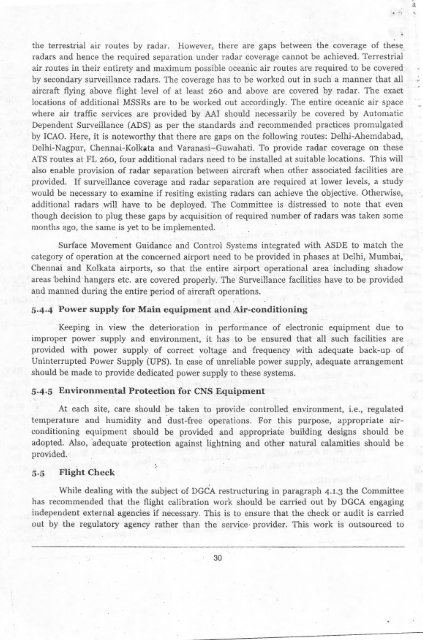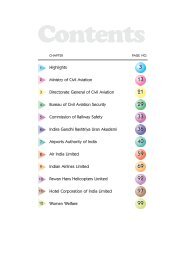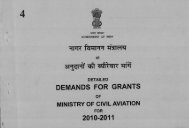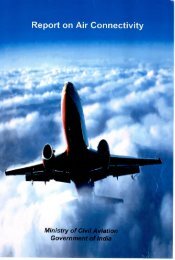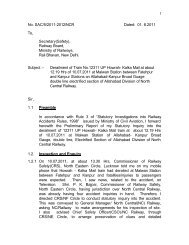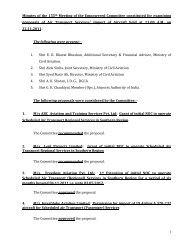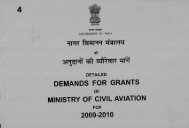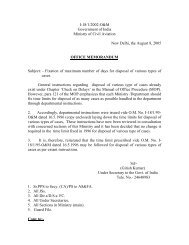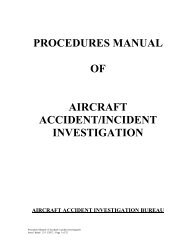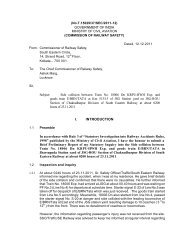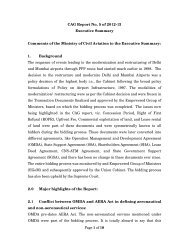3 - Ministry of Civil Aviation
3 - Ministry of Civil Aviation
3 - Ministry of Civil Aviation
Create successful ePaper yourself
Turn your PDF publications into a flip-book with our unique Google optimized e-Paper software.
the terrestrial air routes by radar. However, there are gaps between the coverage <strong>of</strong> theseradars and hence the required separation under radar coverage cannot be achieved. Terrestrialair routes in their entirety and maximum possible oceanic air routes are required to be coveredby secondary surveillance radars. The coverage has to be worked out in such a manner that allaircraft flying above flight level <strong>of</strong> at least 260 and above are covered by radar. The exactlocations <strong>of</strong> additional MSSRs are to be worked out accordingly. The entire oceanic air spacewhere air traffic services are provided by AAI should necessarily be covered by AutomaticDependent Surveillance (ADS) as per the standards and recommended practices promulgatedby ICAO. Here, it is noteworthy that there are gaps on the following routes: Delhi-Ahemdabad,Delhi-Nagpur, Chennai-Kolkata and. Varanasi—Guwahati. To provide radar coverage on theseATS routes at FL 260, four additional radars need to be installed at suitable locations. This willalso enable provision <strong>of</strong> radar separation between aircraft when other associated facilities areprovided. If surveillance coverage and radar separation are required at lower levels, a studywould be necessary to examine if resiting existing radars can achieve the objective. Otherwise,additional radars will have to be deployed. The Committee is distressed to note that eventhough decision to plug these gaps by acquisition <strong>of</strong> required number <strong>of</strong> radars was taken somemonths ago, the same is yet to be implemented.Surface Movement Guidance and Control Systems integrated with ASDE to match thecategory <strong>of</strong> operation at the concerned airport need to be provided in phases at Delhi, Mumbai,Chennai and Kolkata airports, so that the entire airport operational area including shadowareas behind hangers etc. are covered properly. The Surveillance facilities have to be providedand manned during the entire period <strong>of</strong> aircraft operations.5.4.4 Power supply for Main equipment and Air-conditioningKeeping in view the deterioration in perforMance <strong>of</strong> electronic equipment due toimproper power 'supply and environment, it has to be ensured that all such facilities areprovided with power supply. <strong>of</strong> correct voltage and frequency with adequate back-up. <strong>of</strong>Uninterrupted Power Supply (UPS). In case <strong>of</strong> unreliable power supply, adequate arrangementshould be made to provide dedicated power supply to these systems.5.4.5 Environmental Protection for CNS EquipmentAt each site, care should be taken to provide 'controlled environment, i.e., regulatedtemperature and humidity and dust-free operations. For this purpose, appropriate airnditioningequipment should be provided and appropriate building designs should beadopted. Also, adequate protection against lightning and other natural calamities should beprovided.5.5 Flight CheckWhile dealing with the subject <strong>of</strong> DGCA restructuring in paragraph 4.1.3 the Committeehas recommended that the flight calibration work should be carried out by DGCA engagingindependent external agencies if necessary. This is to ensure that the check or audit is carriedout by the regulatory agency rather than the service. provider. This work is outsourced to30


